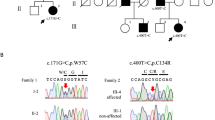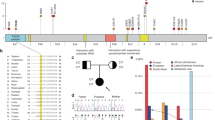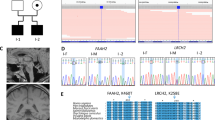Abstract
Autosomal dominant cerebellar ataxia (ADCA) is a genetically heterogeneous group of neurodegenerative disorders with overlapping clinical presentation. Recently, a single nucleotide substitution in the 5′-untranslated region (UTR) of the puratrophin-1 (PLEKHG4) gene on chromosome 16q22.1 has been shown to be associated with ADCA in 52 unrelated Japanese families. As this mutation has so far not been investigated in other populations, we have screened 537 European patients with a clinical diagnosis of cerebellar ataxia for this specific nucleotide substitution. The mutation was not identified in our cohort. In addition, we screened the complete 5′-UTR as well as the entire coding region of this gene in 120 patients for variations that might account for their clinical symptoms. Several new rare variations were found. For none of the variations could an obvious pathogenetic relevance be postulated at this point, albeit some findings should be followed up in additional populations and by functional assays. We conclude that mutations of the puratrophin-1 gene are not a common cause of hereditary ataxia in our Caucasian population.
Similar content being viewed by others
Log in or create a free account to read this content
Gain free access to this article, as well as selected content from this journal and more on nature.com
or
References
Cagnoli C, Mariotti C, Taroni F, Seri M, Brussino A, Michielotto C, Grisoli M, Di Bella D, Migone N, Gellera C, Di Donato S, Brusco A (2006) SCA28, a novel form of autosomal dominant cerebellar ataxia on chromosome 18p11.22-q11.2. Brain 129:235–242
Flanigan K, Gardner K, Alderson K, Galster B, Otterud B, Leppert MF, Kaplan C, Ptacek LJ (1996) Autosomal dominant spinocerebellar ataxia with sensory axonal neuropathy (SCA4): clinical description and genetic localization to chromosome 16q22.1. Am J Hum Genet 59:392–399
Godde R, Rohde K, Becker C, Toliat MR, Entz P, Suk A, Muller N, Sindern E, Haupts M, Schimrigk S, Nurnberg P, Epplen JT (2005) Association of the HLA region with multiple sclerosis as confirmed by a genome screen using >10,000 SNPs on DNA chips. J Mol Med 83:486–494
Hellenbroich Y, Bubel S, Pawlack H, Opitz S, Vieregge P, Schwinger E, Zuhlke C (2003) Refinement of the spinocerebellar ataxia type 4 locus in a large German family and exclusion of CAG repeat expansions in this region. J Neurol 250:668–671
Hellenbroich Y, Pawlack H, Rub U, Schwinger E, Zuhlke C (2005) Spinocerebellar ataxia type 4 Investigation of 34 candidate genes. J Neurol 252:1472–1475
Ishikawa K, Toru S, Tsunemi T, Li M, Kobayashi K, Yokota T, Amino T, Owada K, Fujigasaki H, Sakamoto M, Tomimitsu H, Takashima M, Kumagai J, Noguchi Y, Kawashima Y, Ohkoshi N, Ishida G, Gomyoda M, Yamanouchi H, Mizutani T, Kondo I, Toda T, Mizusawa H (2005) An autosomal dominant cerebellar ataxia linked to chromosome 16q22.1 is associated with a single-nucleotide substitution in the 5′ untranslated region of the gene encoding a protein with spectrin repeat and rho guanine-nucleotide exchange-factor domains. Am J Hum Genet 77:280–296
Jaeckel S, Epplen JT, Kauth M, Miterski B, Tschentscher F, Epplen C (1998) Polymerase chain reaction-single strand conformation polymorphism or how to detect reliably and efficiently each sequence variation in many samples and many genes. Electrophoresis 19:3055–3061
Koeppen AH (2005) The pathogenesis of spinocerebellar ataxia. Cerebellum 4:62–73
Nagaoka U, Takashima M, Ishikawa K, Yoshizawa K, Yoshizawa T, Ishikawa M, Yamawaki T, Shoji S, Mizusawa H (2000) A gene on SCA4 locus causes dominantly inherited pure cerebellar ataxia. Neurology 54:1971–1975
Schols L, Bauer P, Schmidt T, Schulte T, Riess O (2004) Autosomal dominant cerebellar ataxias: clinical features, genetics, and pathogenesis. Lancet Neurol 3:291–304
van de Warrenburg BP, Verbeek DS, Piersma SJ, Hennekam FA, Pearson PL, Knoers NV, Kremer HP, Sinke RJ (2003) Identification of a novel SCA14 mutation in a Dutch autosomal dominant cerebellar ataxia family. Neurology 61:1760–1765
Yabe I, Sasaki H, Chen DH, Raskind WH, Bird TD, Yamashita I, Tsuji S, Kikuchi S, Tashiro K (2003) Spinocerebellar ataxia type 14 caused by a mutation in protein kinase C gamma. Arch Neurol 60:1749–1751
Author information
Authors and Affiliations
Corresponding author
Rights and permissions
About this article
Cite this article
Wieczorek, S., Arning, L., Alheite, I. et al. Mutations of the puratrophin-1 (PLEKHG4) gene on chromosome 16q22.1 are not a common genetic cause of cerebellar ataxia in a European population. J Hum Genet 51, 363–367 (2006). https://doi.org/10.1007/s10038-006-0372-y
Received:
Accepted:
Published:
Issue date:
DOI: https://doi.org/10.1007/s10038-006-0372-y
Keywords
This article is cited by
-
Single-cell epigenomics and spatiotemporal transcriptomics reveal human cerebellar development
Nature Communications (2023)
-
Analysis of an insertion mutation in a cohort of 94 patients with spinocerebellar ataxia type 31 from Nagano, Japan
neurogenetics (2010)
-
Severity and Progression Rate of Cerebellar Ataxia in 16q-linked Autosomal Dominant Cerebellar Ataxia (16q-ADCA) in the Endemic Nagano Area of Japan
The Cerebellum (2009)
-
Spinocerebellar ataxia type 4 and 16q22.1-linked Japanese ataxia are not allelic
Journal of Neurology (2008)
-
Redefining the disease locus of 16q22.1-linked autosomal dominant cerebellar ataxia
Journal of Human Genetics (2007)



